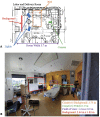Evaluation of Respiratory Emissions During Labor and Delivery: Potential Implications for Transmission of Severe Acute Respiratory Syndrome Coronavirus 2 (SARS-CoV-2)
- PMID: 34623073
- PMCID: PMC8462302
- DOI: 10.1097/AOG.0000000000004533
Evaluation of Respiratory Emissions During Labor and Delivery: Potential Implications for Transmission of Severe Acute Respiratory Syndrome Coronavirus 2 (SARS-CoV-2)
Abstract
Objective: To characterize respiratory emissions produced during labor and vaginal delivery vis-à-vis the potential for transmission of severe acute respiratory syndrome coronavirus 2 (SARS-CoV-2).
Methods: Observational study of three women who tested negative for SARS-CoV-2 and had uncomplicated vaginal deliveries. Using background-oriented schlieren imaging, we evaluated the propagation of respiratory emissions produced during the labor course and delivery. The primary outcome was the speed and propagation of breath over time, calculated through processed images collected throughout labor and delivery.
Results: In early labor with regular breathing, the speed of the breath was 1.37 meters/s (range 1.20-1.55 meters/s). The breath appeared to propagate faster with a cough during early labor at a speed of 1.69 meters/s (range 1.22-2.27 meters/s). During the second stage of labor with Valsalva and forced expiration, the propagation speed was 1.79 meters/s (range 1.71-1.86 meters/s).
Conclusion: Labor and vaginal delivery increase the propagation of respiratory emissions that may increase risk of respiratory transmission of SARS-CoV-2.
Copyright © 2021 by the American College of Obstetricians and Gynecologists. Published by Wolters Kluwer Health, Inc. All rights reserved.
Conflict of interest statement
Financial Disclosure The authors did not report any potential conflicts of interest.
Figures


References
Publication types
MeSH terms
LinkOut - more resources
Full Text Sources
Other Literature Sources
Medical
Miscellaneous

